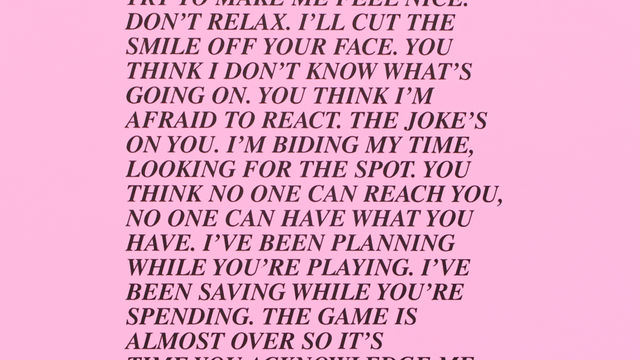
Jenny Holzer
Jenny Holzer's artistic medium is words and ideas, and she uses a variety of vehicles—from stickers, posters, and T-shirts to benches, bronze plaques, electronic displays, and the Internet—to disseminate her piercingly incisive phrases in public spaces. Rooted in conceptual art, semiotics, and feminism, Holzer's artistic practice interrogates the effects of rhetoric, engaging spectators in fundamental questions such as "Who is speaking?" "Where does this text come from?" and "What does it mean?" Answers, however, remain productively elusive. Her texts—whether directives, confessions, or observations—elide authorial intentionality and unlock a sort of societal subconscious, from which hacked-up bits of ideology, desire, fear, humor, and hatred pour forth.
Beginning with Truisms (1977–79), Holzer has authored dozens of textual series that—while distinct in personality, tone, and subject—often resurface in various material forms over time.# Her Inflammatory Essays (1979–81) are a series of mass-produced short essays—one hundred words in twenty lines—printed in capital letters on colorful paper and originally displayed anonymously in the streets.# The essays cover a variety of subjects that have been ongoing concerns throughout Holzer's career, including power, social control, abuse, consumption, and sex. Declarative and forceful in tone, they embody Holzer's distinctively crafted voice, one that is omniscient, detached, and yet enraged. "Don't talk down to me. Don't be polite to me. Don't try to make me feel nice. Don't relax. I'll cut the smile off your face," begins the essay on light pink paper. The "author" projected by these texts, however, is never clear but rather shifts between multiple, conflicting political and gender identities. The texts, as David Joselit has suggested, are "nowhere and everywhere—both uncannily personal and rigidly ideological."#

In the current era of terror, Holzer has turned her attention to the erasure of language and information in declassified government documents. Part of her series of thirty-two Redaction Paintings, MEMORANDUM FOR CONDOLEEZZA RICE GREEN (2006) reproduces a magnified copy of a typed memo, dated January 25, 2001, from Richard C. Clarke of the National Security Council to then secretary of state Condoleezza Rice seeking clarification on terrorist threats. Screen-printed black text on bright green, the memo requests a review of the "al Qida network" (eight months before 9/11) and inquires about funding groups in opposition to "the Taliban/al Qida," such as the Afghan Northern Alliance, the perceived "threat magnitude" from the terrorist network, and the Bush administration's intended strategy. Holzer's Redaction Paintings—which include witness and soldier depositions, George W. Bush's opinion on the authority of the Geneva Conventions in a period of international terror, and even autopsy reports—index the same unsettling mix of violence, ignorance, and truth that has always intrigued Holzer and remained at the center of her work.
—Ruth Erickson

